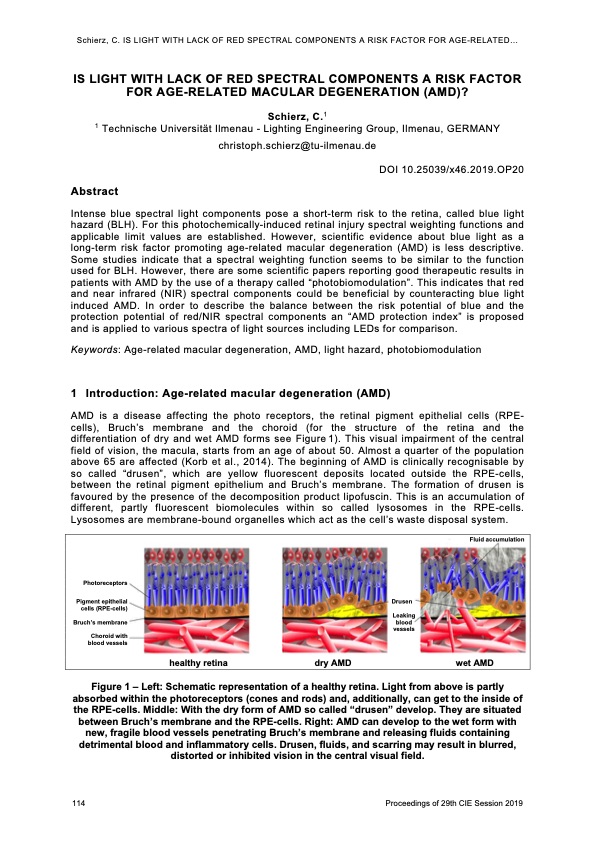
PDF Publication Title:
Text from PDF Page: 002
Schierz, C. IS LIGHT WITH LACK OF RED SPECTRAL COMPONENTS A RISK FACTOR FOR AGE-RELATED... IS LIGHT WITH LACK OF RED SPECTRAL COMPONENTS A RISK FACTOR FOR AGE-RELATED MACULAR DEGENERATION (AMD)? Schierz, C.1 1 Technische Universität Ilmenau - Lighting Engineering Group, Ilmenau, GERMANY Abstract christoph.schierz@tu-ilmenau.de Intense blue spectral light components pose a short-term risk to the retina, called blue light hazard (BLH). For this photochemically-induced retinal injury spectral weighting functions and applicable limit values are established. However, scientific evidence about blue light as a long-term risk factor promoting age-related macular degeneration (AMD) is less descriptive. Some studies indicate that a spectral weighting function seems to be similar to the function used for BLH. However, there are some scientific papers reporting good therapeutic results in patients with AMD by the use of a therapy called “photobiomodulation”. This indicates that red and near infrared (NIR) spectral components could be beneficial by counteracting blue light induced AMD. In order to describe the balance between the risk potential of blue and the protection potential of red/NIR spectral components an “AMD protection index” is proposed and is applied to various spectra of light sources including LEDs for comparison. Keywords: Age-related macular degeneration, AMD, light hazard, photobiomodulation 1 Introduction: Age-related macular degeneration (AMD) AMD is a disease affecting the photo receptors, the retinal pigment epithelial cells (RPE- cells), Bruch’s membrane and the choroid (for the structure of the retina and the differentiation of dry and wet AMD forms see Figure 1). This visual impairment of the central field of vision, the macula, starts from an age of about 50. Almost a quarter of the population above 65 are affected (Korb et al., 2014). The beginning of AMD is clinically recognisable by so called “drusen”, which are yellow fluorescent deposits located outside the RPE-cells, between the retinal pigment epithelium and Bruch’s membrane. The formation of drusen is favoured by the presence of the decomposition product lipofuscin. This is an accumulation of different, partly fluorescent biomolecules within so called lysosomes in the RPE-cells. Lysosomes are membrane-bound organelles which act as the cell’s waste disposal system. DOI 10.25039/x46.2019.OP20 Photoreceptors Pigment epithelial cells (RPE-cells) Bruch’s membrane Choroid with blood vessels Drusen Leaking blood vessels Fluid accumulation wet AMD healthy retina dry AMD Figure 1 – Left: Schematic representation of a healthy retina. Light from above is partly absorbed within the photoreceptors (cones and rods) and, additionally, can get to the inside of the RPE-cells. Middle: With the dry form of AMD so called “drusen” develop. They are situated between Bruch’s membrane and the RPE-cells. Right: AMD can develop to the wet form with new, fragile blood vessels penetrating Bruch’s membrane and releasing fluids containing detrimental blood and inflammatory cells. Drusen, fluids, and scarring may result in blurred, distorted or inhibited vision in the central visual field. 114 Proceedings of 29th CIE Session 2019PDF Image | LIGHT WITH LACK OF RED SPECTRAL COMPONENTS v amd

PDF Search Title:
LIGHT WITH LACK OF RED SPECTRAL COMPONENTS v amdOriginal File Name Searched:
x046-OP20.pdfDIY PDF Search: Google It | Yahoo | Bing
Cruise Ship Reviews | Luxury Resort | Jet | Yacht | and Travel Tech More Info
Cruising Review Topics and Articles More Info
Software based on Filemaker for the travel industry More Info
The Burgenstock Resort: Reviews on CruisingReview website... More Info
Resort Reviews: World Class resorts... More Info
The Riffelalp Resort: Reviews on CruisingReview website... More Info
| CONTACT TEL: 608-238-6001 Email: greg@cruisingreview.com | RSS | AMP |